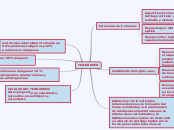ANTIGENOS
In physics, energy is the quantitative property that must be transferred to an object in order to perform work on, or to heat, the object. Energy is a conserved quantity; the law of conservation of energy states that energy can be converted in form, but not created or destroyed
Todas las moléculas tienen antígenos, pero no todos los antígenos son inmunógenos
INMUNÓGENOS
Nuclear
Nuclear energy originates from the splitting of uranium atoms – a process called fission.
This generates heat to produce steam, which is used by a turbine generator to generate electricity. Because nuclear power plants do not burn fuel, they do not produce greenhouse gas emissions.
Write down the advantages and disadvantages of Nuclear Energy.
Disadvantages
Advantages
Factores que afectan la inmunogenicidad
A wind turbine, or alternatively referred to as a wind energy converter, is a device that converts the wind's kinetic energy into electrical energy.
Wind turbines are manufactured in a wide range of vertical and horizontal axis.
Write down the advantages and disadvantages of Wind turbines.
La administración de adyuvantes
Significado de "adyuvante"
Incrementa la inflamación localizada
Incrementa la comunicación entre las células del sistema inmune
Prolongan la persistencia del antígeno
Sustancias que en mezcla con antígenos potencian la inmunogenicidad
La ruta de administración
La dosis administrada
El contexto genético del individuo
¿Qué se debe considerar para ser inmunogénico?
Solar energy begins with the sun. Solar panels are used to convert light from the sun, which is composed of particles of energy called 'photons', into electricity that can be used to power electrical loads.
Write down the benefits of using solar panels.
Ácidos nucleicos
Polisacáridos
Hydrogen fuel is a zero-emission fuel burned with oxygen.
It can be used in fuel cells or internal combustion engines.
Name the advantages and disadvantages of Hydrogen fuel.
Sin excepción todos los inmunógenos son proteínas
Molécula capaz de generar o desarrollar una respuesta inmune en un individuo.
Rubio Torres Abigail - B1
Antígenos T independientes
No generan cambio de tipo de inmunoglobulina IgM a IgG
No generan memoria inmunológica
No requieren estímulo de células T CD4 para la producción de anticuerpos
Antígenos no proteicos
Antígenos T dependientes
There are many different types of energy, which all fall into two primary forms – kinetic and potential.
Energy can transform from one type to another, but it can never be destroyed or created.
Generan cambio de tipo de inmunoglobulina de IgM a IgG
Chemical energy is stored in the bonds of atoms and molecules.
It is the energy that holds these particles together.
Stored chemical energy is found in food, natural gas, etc.
Give more examples.
Generan memoria inmunológica
Nuclear energy is stored in the nucleus of atoms.
This energy is released when the nuclei are combined (fusion) or split apart (fission).
Nuclear power plants split the nuclei of uranium atoms to produce electricity.
What element do they use to fuel nuclear power plants?
Requiere el estímulo de células T CD4 para la producción de anticuerpos
Thermal energy is created from the vibration of atoms and molecules within substances. The faster they move, the more energy they possess and the hotter they become. Thermal energy is also called heat energy.
Give examples of heat energy.
De origen proteicos
Motion energy or mechanical energy is the energy stored in objects; as objects move faster, more energy is stored.
Examples of motion energy include wind, a flowing river, etc.
Give more examples.
¿Qué es?
Energy storage is the capture of energy produced at one time for use at a later time. A device that stores energy is generally called an accumulator or battery.
Puede ser cualquier molécula
The battery acquires its charged condition either by recharging or in the manufacturing of the unit.
During discharge, the chemical on the anode releases electrons, and ions in the electrolyte undergo an oxidation reaction.
Name the particular compounds in which energy is stored:
Moléculas ínorgánicas
Ácido desoxirribonucleico
Lípidos
Sacáridos
Proteínas
Cualquier molécula capaz de unirse específicamente a los componentes del sistema inmune
Flywheel energy storage (FES) works by accelerating a rotor to a very high speed and maintaining the energy in the system as rotational energy.
Write down the main components of a typical flywheel.









